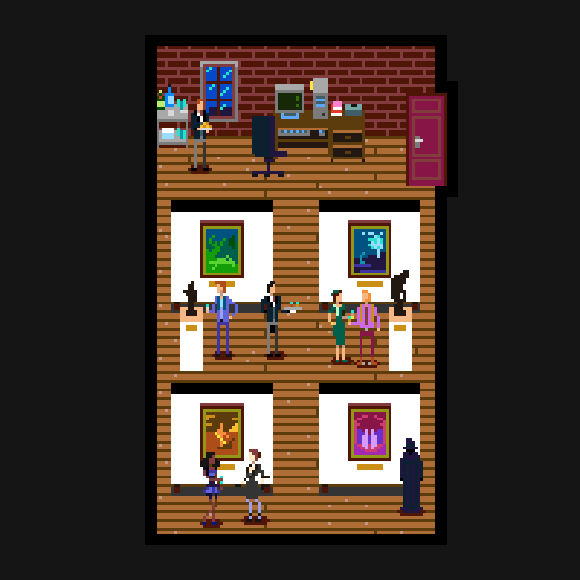Work In Progress!
This week I have little progress to show so maybe it's a good time to share a bit about the design process behind the game.
Lately I've been thinking a lot about puzzles, adventure games and RPGs. Traditional graphic adventures often rely on a single solution for each puzzle, which makes the whole puzzle design a lot easier but constraints the player to follow the logic and the inscrutable thought process of the puzzle designer. I'm a big fan of deep story-driven RPGs that give the player lots of options to solve each game puzzle. Providing multiple solutions reinforces both player agency ('I can solve this puzzle how I want') and role-playing ('this is how my character should solve the puzzle'), making the player feel smart and in-character at the same time. This magic moment of 'choose your own solution' for the puzzles comes at a high price, though. Designing puzzles with multiple solutions is hard as balls. And I think that's why more often than not RPGs rely on systems rather than hand-crafted solutions for each puzzle. Tthere are exceptions, of course, but the majority of story-driven RPGs use a systemic approach to puzzles instead of writing 15 solutions for each puzzle. I know because I started doing the later and the amount of work to complete a small number of puzzles was becoming unbearable. So I turned to systems and eveything started coming into place. Let me explain myself with an example:

This is Gallery Noir, a cool art gallery in Santa Monica that is showing an exposition of vampiric paintings and sculptures. You're tasked with a quest to slash the paintings and steal the charity box. The problem here is that there are a lot of guests in the gallery and that makes the slashing a lot more difficult. My first approach was to provide the obvious solution: you have a knife and lots of charisma so you can talk with each guest and convince them to leave the gallery, then you can slash the paintings and pick up the carity box. However, what if you feel like intimidating the guests with your knife? Of what if you decide to poison the catering or the drinks? And how about the computer? Maybe you can turn off the lights and do the slashing in the dark? These are all viable solutions but they fit a lot easier in the game if there's a skill system in place that allows the player to intimidate NPCs using a weapon, poison NPCs using food or drink and hack into computers. These systems may work in different puzzles too, so the amount of work for designing the puzzles is greatly reduced.

Here's another example. The room on the left is the hiding spot of a vampire hacker, Bernard Thung. The room on the right is Arthur Killpatrick's bailbonds store. The computer security level of these two characters is totally different (one uses all standard security protocols while the other types with the index finger). The hacking system takes into account the different levels of difficulty of the hacking attempt. But what if you haven't learned the hacking skill? Maybe you can look at the environment and piece together different evidences in order to make an educated guess about each character's password. Note that Killpatrick has a post-int on the monitor which probably gives you a pretty solid clue about the password.
Again, working with systems makes each solution reusable in different puzzles. Hand-crafted solutions are more beautiful but harder to pull off. This balance between systems and puzzles is driving my design process while I try to land a middle point between graphic adventure and story-driven RPG.
Get Bloodlust: Santa Monica
Bloodlust: Santa Monica
demake of Vampire: The Masquerade: Bloodlines as a 2D point & click adventure with retro pixelart
| Status | Released |
| Author | Emanuel Montero |
| Genre | Adventure |
| Tags | 8-Bit, Demake, dialogue, Fangame, Female Protagonist, Gothic, Pixel Art, Point & Click, storygame, Vampire |
| Languages | English |
| Accessibility | Subtitles |
More posts
- 🧛♀️Walkthrough🕵️Sep 07, 2024
- Version 1.2 fixes some WebGL bugs!Sep 27, 2020
- Version 1.1 is full of bugfixes!Jan 25, 2020
- Version 1.0 is out now!Jan 04, 2020
- Character Selection Screen!Dec 05, 2019
- Dialog SFX!May 13, 2019
- Hacking!May 05, 2019
- Music & SFX!Apr 29, 2019
- Beach House!Mar 02, 2019

Leave a comment
Log in with itch.io to leave a comment.